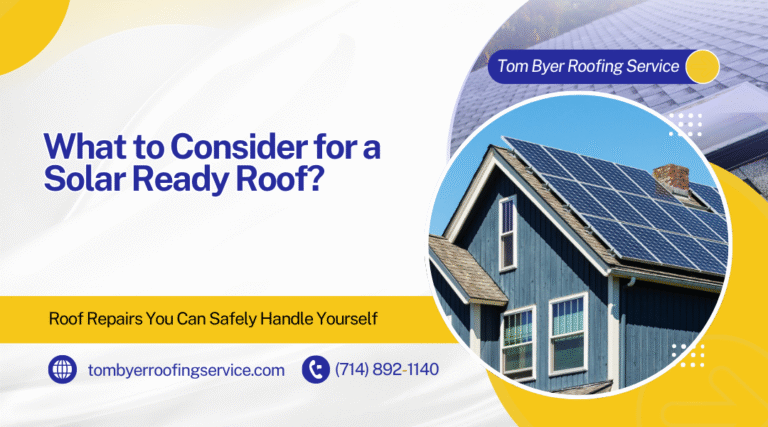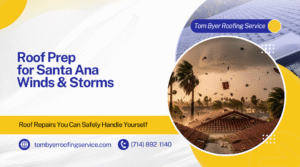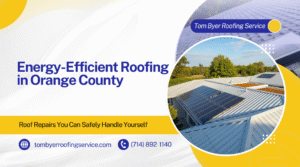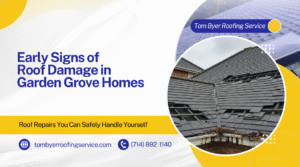Garden Grove homeowners considering solar panels face a critical decision that extends beyond just choosing the right panels. The condition and suitability of your roof plays a fundamental role in the success of any solar installation. Before installing solar panels, ensuring your roof is in good condition is essential because it’s more cost-effective to repair or replace a roof before installation than to remove and reinstall panels later.
Solar-ready roofing involves specific structural requirements, optimal angles, and proper materials that maximize energy efficiency and system longevity. Factors such as roof age, material type, structural integrity, and local building codes all influence whether a roof can support solar panels effectively. Garden Grove’s unique climate conditions and municipal regulations add another layer of considerations that homeowners must navigate.
Understanding these requirements upfront helps homeowners make informed decisions about timing, costs, and necessary upgrades. Tom Byer Roofing Service brings decades of experience in preparing Garden Grove roofs for solar installations, ensuring homeowners avoid costly mistakes and maximize their investment in renewable energy.
What Makes a Roof Solar-Ready?
A solar-ready roof combines proper structural capacity, suitable materials, and strategic design elements that support efficient panel installation. Preparation prevents costly delays and ensures optimal system performance for decades.
Definition and Key Characteristics
A solar-ready roof meets specific structural and material requirements for safe panel installation. The roof must support additional weight loads of 20-50 pounds per square foot depending on panel type.
Structural soundness forms the foundation. Rafters and trusses need adequate spacing and load-bearing capacity. Most installations require 16-inch or 24-inch on-center framing.
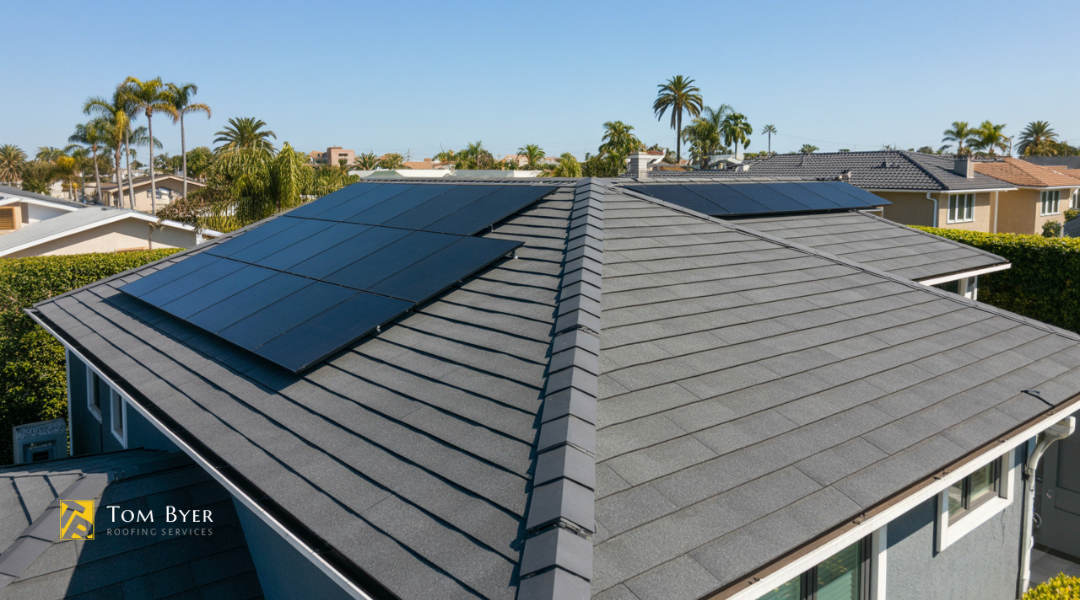
Proper orientation maximizes energy production. South-facing roof sections with slopes between 15-40 degrees perform best in Garden Grove’s climate.
Quality roofing materials ensure longevity. Architectural asphalt shingles, standing-seam metal, and concrete tiles work well with solar systems. These materials provide secure mounting points and resist weathering.
Electrical readiness includes accessible pathways for wiring. The electrical panel should have sufficient capacity for solar interconnection, typically requiring 200-amp service.
Age matters significantly. Roofs under 10 years old rarely need replacement before solar installation.
Common Issues That Delay Solar Installation
Structural deficiencies top the list of installation delays. Sagging rafters, inadequate load capacity, or damaged decking require repairs before panels can be mounted safely.
Roof age and condition create frequent obstacles. Shingles nearing replacement, damaged flashing, or worn underlayment need addressing first. Installing panels on aging roofs leads to expensive removal costs later.
Electrical system limitations halt many projects. Older homes with 100-amp panels or outdated wiring require upgrades. Panel locations far from the main electrical service increase installation complexity.
Shading issues from trees, neighboring structures, or roof features reduce system efficiency. These problems need resolution through trimming, design modifications, or alternative placement strategies.
Permit complications arise from code violations or unpermitted roof modifications. Missing permits for previous work can delay solar approvals significantly.
Key Roof Factors That Affect Solar Panel Installation
Several critical factors determine whether a roof can successfully support solar panels. The age and structural condition, orientation and pitch, and roofing material type all directly impact installation feasibility and long-term performance.
Age and Condition of the Existing Roof
Roof age plays a crucial role in solar panel installation decisions. Most roofing materials have lifespans between 15-30 years depending on the material type.
Installing solar panels on a roof nearing replacement creates complications. Solar panels typically last 25-30 years, so the roof should have sufficient remaining life to match this timeframe.
Key condition factors include:
- Missing or damaged shingles
- Sagging sections indicating structural weakness
- Water damage or leak evidence
- Deteriorated flashing around penetrations
Structural integrity must support additional weight loads. Solar panels add approximately 2-4 pounds per square foot to the roof structure.
Professional inspection identifies potential issues before installation. Addressing roof repairs beforehand prevents costly panel removal and reinstallation later.
Roof Pitch, Direction, and Sunlight Exposure
Roof orientation significantly affects solar energy production. South-facing roofs receive optimal sunlight exposure throughout the day in California.
Optimal specifications include:
- Direction: South-facing (180°)
- Acceptable alternatives: Southeast (135°) or Southwest (225°)
- Pitch angle: 30-45 degrees for maximum efficiency
Roof pitch impacts panel performance and installation complexity. Steep pitches above 45 degrees create installation challenges and safety concerns.
Flat roofs require mounting systems that tilt panels to proper angles. This approach uses more roof space but allows optimal positioning regardless of building orientation.
Shading assessment identifies obstructions like trees, buildings, or chimneys. Even partial shading on one panel can reduce entire system output significantly.
Material Compatibility: Asphalt, Tile, Metal, Flat Roofing
Different roofing materials require specific mounting approaches and considerations for solar panel installation.
Asphalt shingles offer the most straightforward installation process. Standard mounting systems penetrate directly through shingles into roof decking with proper flashing and sealing.
Clay and concrete tiles require careful handling to prevent cracking. Installers may need to remove tiles temporarily, install mounting hardware, then replace tiles around mounting points.
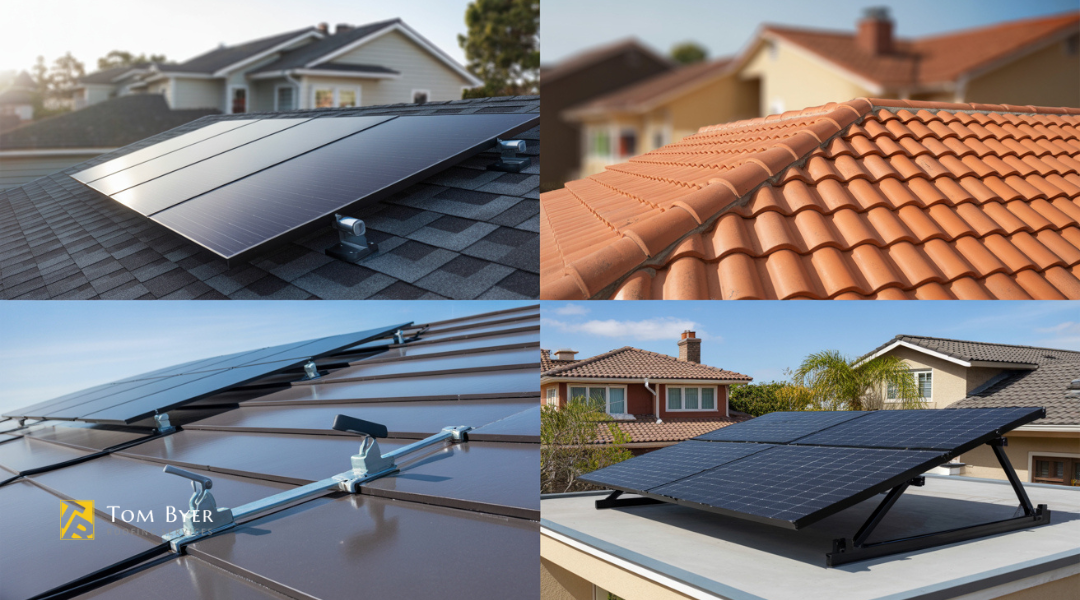
Metal roofing provides excellent compatibility with specialized clamps. These systems often avoid roof penetrations entirely by attaching to seams or standing ribs.
Flat roofing systems typically use ballasted mounting without penetrations. The mounting system relies on weight and wind deflectors to secure panels in position.
Each material type affects installation costs and timeline. Metal roofs generally cost less to outfit with solar panels compared to tile roofs requiring extensive tile work.
Pre-Solar Roofing Upgrades to Consider
Smart homeowners evaluate their roof’s readiness before solar installation to avoid costly modifications later. Critical upgrades include full replacement for aging roofs, integrated conduit systems, and structural reinforcements that support long-term panel performance.
When a Full Roof Replacement Is Recommended
Roofs approaching 15-20 years of age typically require replacement before solar panel installation. Installing panels on an aging roof creates expensive complications when future roof repairs become necessary.
Key replacement indicators include:
- Damaged or missing shingles
- Granule loss on asphalt shingles
- Sagging areas or structural concerns
- Multiple leak repairs in recent years
The timing matters significantly for homeowners. Replacing a roof after panel installation costs 40-60% more due to panel removal and reinstallation fees.
Tom Byer Roofing Service evaluates structural integrity during roof inspections. They identify compromised decking, damaged rafters, or inadequate ventilation that could affect panel performance.
New roofing materials provide better warranties when installed simultaneously with solar systems. This approach eliminates the risk of voiding either the roofing or solar warranty due to installation conflicts.
Built-In Conduit and Mounting Prep During Re-Roofing
Integrated conduit systems installed during roof replacement eliminate visible wiring and reduce installation time. Pre-planned electrical pathways create cleaner installations and better weather protection.
Essential conduit considerations:
- PVC conduit runs from panel areas to electrical panels
- Weatherproof junction boxes at strategic roof locations
- Grounding wire pathways for electrical code compliance
Mounting preparation involves reinforcing roof areas where panels will attach. Additional blocking between rafters distributes weight loads across larger structural areas.
Flashing integration becomes simpler when planned during initial roof installation. Pre-installed flashing systems around mounting points prevent water infiltration that commonly occurs with retrofit installations.
Electrical rough-in work coordinates with solar installers to ensure proper amperage capacity. Upgraded electrical panels may require installation before solar connection approval.
Flashing, Anchors, and Load-Bearing Considerations
Proper flashing systems prevent water damage at panel mounting points. Integrated flashing installed during roofing provides superior protection compared to retrofit applications applied over existing shingles.
Structural anchoring requires evaluation of rafter spacing and load capacity. Standard residential roofs support 2-4 pounds per square foot of additional panel weight.
Critical anchor specifications:
- Lag bolts minimum 5 inches into structural rafters
- Stainless steel hardware prevents corrosion
- Sealant application around all penetration points
Load-bearing assessments examine existing roof framing for adequacy. Older homes may require additional support beams or rafter reinforcement before panel installation.
Wind uplift considerations become important in Garden Grove’s climate conditions. Proper anchor spacing and edge reinforcement prevent panel movement during high wind events.
Tom Byer Roofing Service coordinates with structural engineers when load calculations exceed standard residential capacity. This prevents future structural problems that compromise both roof and solar system integrity.
Garden Grove Regulations and Solar Roofing Codes
Garden Grove requires specific permits and inspections for solar installations while following California’s Title 24 energy standards. Proper coordination between roofing contractors and solar installers ensures compliance with local building codes and safety requirements.
City Permitting and Inspection Requirements
Garden Grove’s Building & Safety Division administers all solar installation permits under state and local building regulations. These standards protect life, health, property, and public welfare through controlled design and construction requirements.
Solar domestic water heating systems qualify for expedited permitting when homeowners complete the Eligibility Checklist. All criteria must be met for fast-track approval.
Required permits include:
- Building permits for structural modifications
- Electrical permits for system connections
- Roofing permits when roof work is involved
The city requires inspections at multiple stages. Contractors must provide safe ladder access for each inspection appointment.
Property owners can submit applications through Garden Grove’s Development Access Website. The system handles residential, commercial, and engineering permits electronically.
Appeals of Building Official decisions go before the Administrative Board of Appeals. This board reviews orders, decisions, and interpretations of Garden Grove’s building codes.
California Title 24 Energy Standards
California’s Title 24 establishes the legal framework for solar access rights. The law protects homeowners’ and businesses’ right to access sunlight for energy generation.
Local governments have limited authority to restrict solar installations. Garden Grove cannot unreasonably prevent solar system installation without losing state funding eligibility.
Key Title 24 provisions:
- Homeowner solar access rights
- HOA restriction limitations
- Local government compliance requirements
- State funding consequences for violations
The standards apply to new construction and retrofit projects. Solar-ready roofing must accommodate future panel installations without structural modifications.
Energy efficiency requirements often make solar installations cost-effective. The standards encourage renewable energy adoption through streamlined approval processes.
Coordination Between Roofers and Solar Installers
Roofing contractors must coordinate with solar installers to ensure proper structural support. The roof must handle additional weight loads from panels and mounting systems.
Critical coordination points:
- Structural assessment timing
- Warranty responsibility divisions
- Installation sequence planning
- Code compliance verification
Reroofing may be required before solar installation when existing materials are inadequate. Wood shake, slate, clay, cement, or asbestos-cement tiles typically need replacement.
Water-soaked or deteriorated roof coverings cannot support solar equipment. Roofs with two or more covering applications require complete removal before solar work begins.
Solar installers handle permitting when homeowners hire them directly. However, roofing work still requires separate permits and inspections from Garden Grove’s building department.
Proper sequencing prevents warranty conflicts. Roofing work should be completed and inspected before solar installation begins to ensure clear responsibility lines.
Cost, Timing, and Return on Investment
Combining roof preparation with solar panel installation creates significant cost savings compared to separate projects. The timing of roof work directly impacts long-term energy savings and property value increases.
Aligning Roof Work with Solar Panel Installation
Homeowners save $4,000 or more when combining roof replacement with solar installation compared to separate projects. This coordination eliminates duplicate labor costs and material handling fees.
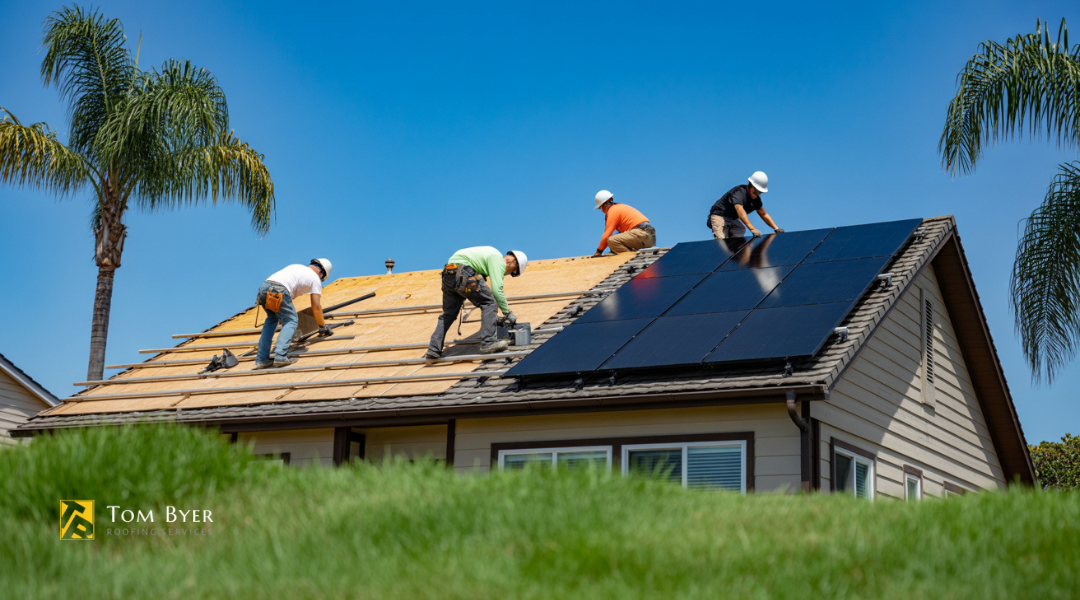
The combined project timeline typically spans 2-4 weeks. Roofing contractors complete structural work first, followed by solar panel installation by certified technicians.
Key timing considerations:
- Schedule roof work during optimal weather conditions
- Allow 2-3 weeks for permit approvals
- Coordinate utility interconnection requirements
Solar panels require roof removal during future replacements. Installing both systems simultaneously prevents this costly disruption that can cost $2,000-$5,000 in panel removal and reinstallation fees.
Professional coordination between roofing and solar contractors ensures proper installation sequencing. This collaboration prevents warranty conflicts and ensures both systems meet manufacturer specifications.
Cost Efficiency of Preparing the Roof in Advance
Solar-ready roof preparation costs represent a fraction of future retrofit expenses. Structural reinforcements during initial construction cost 60-70% less than post-installation modifications.
Advance preparation savings:
- Conduit installation: $500-$800 vs $1,200-$1,800 retrofit
- Structural reinforcement: $800-$1,200 vs $2,000-$3,500 later
- Electrical rough-in: $300-$600 vs $800-$1,400 retrofit
Roof materials suitable for solar installation may cost $1-$3 more per square foot initially. However, this premium prevents $8,000-$15,000 in roof modifications needed for non-compatible materials.
Solar-ready features include reinforced mounting points and pre-installed conduit pathways. These additions streamline future installations and reduce labor requirements by 40-50%.
Long-Term Benefits of a Solar-Ready Roof
Solar panel systems typically generate 15-25% annual returns on investment through energy savings. Combined roof and solar projects maximize this return by eliminating future installation disruptions.
Property values increase by approximately 4% with solar installations. Solar-ready roofs maintain this value advantage while providing installation flexibility for timing energy system additions.
Financial benefits timeline:
- Years 1-3: Tax credit recovery and reduced energy costs
- Years 4-8: Full investment payback period
- Years 9-25: Pure savings averaging $1,200-$2,400 annually
Energy independence reduces utility rate exposure over 25-year panel lifespans. Fixed energy costs protect against utility rate increases averaging 2-3% annually in California.
Solar-ready roofs qualify for federal tax credits when panels are installed. This 30% credit applies to both solar equipment and related roof modifications completed during the same project.
How Tom Byer Roofing Service Helps Homeowners Go Solar
Tom Byer Roofing Service leverages over 60 years of roofing experience to guide Garden Grove homeowners through the solar installation process. The company provides comprehensive roof assessments, partners with solar installers, and ensures proper structural preparation for panel systems.
Local Experience with Roofing + Solar Projects
Tom Byer Roofing Service brings decades of experience working with Southern California’s unique climate conditions. The company understands how intense sun exposure, occasional rain, and coastal air affect both roofing materials and solar panel installations.
Their team has worked on numerous residential and commercial properties throughout Garden Grove and Orange County. This local knowledge helps them identify potential challenges before they become costly problems.
Key advantages of their local expertise:
- Understanding of local building codes and permit requirements
- Experience with different roof types common in Garden Grove neighborhoods
- Knowledge of which roofing materials work best with solar installations
- Familiarity with utility interconnection requirements in the area
The company’s established presence since 1952 means they have relationships with local inspectors and contractors. This network helps streamline the approval process for solar-ready roofing projects.
Pre-Installation Inspections and Readiness Reports
Before any solar panels go up, Tom Byer Roofing Service conducts thorough roof inspections. These assessments determine if the existing roof structure can support the additional weight and equipment.
The inspection process covers several critical areas:
| Inspection Area | What They Check |
|---|---|
| Structural integrity | Roof decking, rafters, and support beams |
| Roofing material condition | Age, wear patterns, and remaining lifespan |
| Electrical systems | Existing wiring and panel access points |
| Ventilation | Adequate airflow around future panel locations |
They provide detailed reports that outline any necessary repairs or upgrades. This documentation helps homeowners understand exactly what work needs completion before solar installation begins.
The company also identifies optimal panel placement areas based on roof orientation and shading patterns.
Collaborating with Solar Providers for Seamless Installs
Tom Byer Roofing Service works directly with solar installation companies to coordinate projects. This collaboration ensures that roofing work aligns with solar system requirements from the start.
Their coordination process includes sharing structural assessments with solar installers. This information helps solar companies design systems that work within the roof’s capabilities.
The roofing team handles all necessary structural modifications before solar installation begins. They install proper mounting points, upgrade decking if needed, and ensure waterproofing around attachment points.
Benefits of this collaborative approach:
- Reduced project timeline delays
- Better warranty coverage for both roofing and solar components
- Single point of contact for any issues that arise
- Coordinated scheduling to minimize disruption
They maintain communication throughout the entire process to address any unexpected issues quickly.

